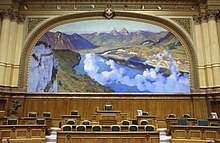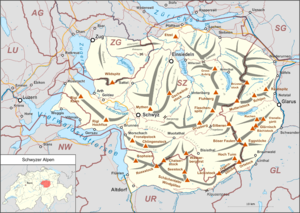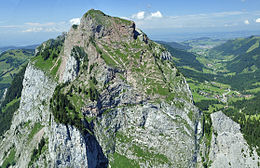Myths
| Myths | ||
|---|---|---|
|
Small and big myths |
||
| height | 1898.1 m above sea level M. (Big Myths) | |
| location |
|
|
| Mountains | Schwyz Alps | |
| Dominance | 8 km → Chlingenstock | |
| Notch height | 492 m ↓ Ibergeregg to Hoch-Ybrig | |
| Coordinates | 695 034 / 209 499 | |
|
|
||
| Normal way | Well secured, steep T3 path from Holzegg | |
|
South-east walls of the two Mythen as well as the far right of the Haggenspitz |
||
The Mythen (pronunciation: [ ˈmiːtən ]) are a mountain range in the Schwyz Alps , consisting of the two distinctive rock pyramids of the Great Mythen at 1898 m above sea level. M. and the small myths 1811 m above sea level. M. with the secondary peak Haggenspitz 1761 m above sea level. M. They were formerly also called Hakenberge .
The Mythen are the landmark of the canton capital Schwyz in Central Switzerland .
location
The myths lie between the Schwyz basin, which they close in the northeast, and the Alptal . The peaks protrude from the surrounding area, visible from afar, and drop in the west almost 1400 meters down to Schwyz. Between the large and the small Mythen (also Gross Mythen and Klein Mythen ) lies at 1438 m above sea level. M. of Zwüschet myths called saddle .
The river Alp , a tributary of the Sihl, rises east of the Mythen .
The mountain range forms a federal hunting ban area .
Development
From Brunni SZ , the last settlement in the Alptal, the Brunni-Holzegg cable car leads to the Holzegg , the pass crossing from the Alptal to Schwyz. The Holzegg is also easily accessible from Rickenbach near Schwyz (with the Rotenflue railway, with an additional 30-minute walk T1 ).
The mountain path on the Grosse Mythen, which can be walked between May and November, begins at Holzegg and climbs steeply 500 meters on the south flank in 47 bends. The ascent is a mountain hike with difficulty level T3 according to the SAC hiking scale . The partially exposed but well-secured footpath is used by up to 30,000 people per year. There is a mountain restaurant on the summit, which is climbed by 2,000 people on peak days. The Mythenfreunde Association is responsible for road maintenance and the restaurant .
The Grosse Mythen was probably first climbed around 1790. The development of the mountain coincided with the pioneering days of mountain tourism and alpinism. On December 26th, 1863, in the same year as the Swiss Alpine Club (SAC), the Mythen-Gesellschaft was constituted as a public limited company with the aim of creating the most comfortable way possible and an inn. In 1864 the company commissioned the Gersau building contractor Domenico Taddei to build the path for 3500 francs. The construction work, done by Italian Muratori, lasted four and a half months. Shortly after the opening on September 17, 1864, a fatal accident occurred off the road, in which Captain Valentin Castell fell victim. A first summit hut was built around 1865 by Josef Nauer, one of the company's founders. In 1885 it burned down completely. A new hut with rooms for overnight stays was built in 1886 on the initiative of the Mythen SAC section, which has now been established.
Between 1936 and 1948, the Mythen-Gesellschaft mutated into the Mythenfreunde Association. In 1982 he moved the mountain path away from the sloping Totenplangg in the uppermost part for safety reasons and in 1991 replaced the summit house with a new building. The restaurant has been supplied by helicopter since 1967 , while porters and pack animals as well as a transport cable car were used for a short time before.
In the mountain restaurant there is a regular table that is reserved for the Hunder Club. Only those who have climbed the mountain at least once within a year can become a member. The record holder is Armin Schelbert, who also calls himself “The Man”. On October 5, 2019, he climbed the Mythen for the 5000th time. The former summit host Albert Klein (1969–1998) follows with around 4,500 and Peter Gujer from Einsiedeln with around 3,000 ascents since 1971.
The two lower peaks, the Kleine Mythen and the Haggenspitz, however, are not accessible by the network of hiking trails; their ascent is reserved for climbers and alpine hikers. According to a report in the magazine Alpina from 1907, a group from Zurich who was not known by name managed to cross all three peaks for the first time from the north.
geology
Geologically, the myths are Penninic cliffs , i.e. remnants of the central Penninic nappes .
Today it is clear that the place of origin and the current location of the myths are not identical. The rocks were formed in a part of the primordial Mediterranean Sea and were pushed almost 150 km northwards from there during the construction of the Alps by the fold-like compression of the ocean floor. In the course of the uplift of the Alps, water and ice carved out the relief, destroyed and removed higher ceilings and only left behind relics - today's rock pyramids.
After all, during the last two million years glaciers formed the relief during the ice ages . In the last glacial period (around 70,000 years BC) the combined Reuss-Muota glacier covered the basin. In the Schwyz area, the ice sheet reached a thickness of around 800 meters; consequently the myths stood out as a rock island. Correspondingly, relics of moraines can still be observed on both mountains today . For the most part, however, these were covered by post-glacial landslides from the Mythen area.
Naming
The name researcher Viktor Weibel interprets the name as follows: "The origin of the name lies in the Latin word meta (feminine), which means something like" something towering "."
In the past, the individual mountains were denoted by the feminine gender and their own singular form: It was called “the big and the small myth”, for example in a council minutes from 1552: “under the miten…” The man from Zurich also refers to the feminine gender Geologist Albert Heim in his «Panorama of the Great Myth» (see below) from 1866.
Since around 1870, however, both the feminine gender and the singular form "myth" have increasingly fallen out of use. In written usage (and increasingly also in dialect), only the large myths and the small myths are spoken of today. However, a large part of the Schwyz population still uses the feminine term in dialect, for example "Mier gend uf die grooss Mythä".
Art and literature

Johann Wolfgang von Goethe descended on foot from Haggenegg to Schwyz while traveling in 1775 and 1797. On June 17, 1775, the German poet sketched the myths in pencil on paper. In his memoir Poetry and Truth , he wrote about the mountains: "At these immense, irregular natural pyramids, clouds rose after clouds." On the basis of such descriptions, Goethe's friend Friedrich Schiller , who was never there himself, emphasized the myths in the opening scene of the drama Wilhelm Tell in order to create the impression of grandeur. However, instead of myths, he used the name hook , as in the recently published Atlas Suisse the mountain with "hook M." is designated. Goethe also used the term Haggen .
At the time of the French Revolution, Friedrich Hölderlin also wandered through the area in 1791. With him, the natural formation awakened the memory of an existence close to nature. The Arcadian valley at the foot of the Mythen is the “source of freedom” and the mountain itself is its protective wall, wrote Hölderlin in 1793.
After the opening of the path on the Grosse Mythen, Albert Heim made a two-meter-long lithograph for the Mythen Society in 1866 to depict the panorama of the summit. In 1923 Heim drew a second, even more detailed panorama based on this.
In 1933 Meinrad Inglin published five short stories under the title Youth of a People . In 1968 he made his last story, Wanderer on the Way Home . Both works revolve around human fates and the geological structure of the myths that Inglin has just studied for his last story, as can be seen from his estate.
On the occasion of the 700th anniversary of the Swiss Confederation , Herbert Meier's Mythenspiel was performed as an official festival at the foot of Schwyz's local mountains in the summer of 1991 .
literature
- Emil Zopfi , Robert Bösch (photographer): The Myths - In the heart of Switzerland. AS Verlag , Zurich 2012, ISBN 978-3-909111-96-1 . ( Reading sample )
photos
Brunnen SZ and Fronalpstock (right) and Mythen (left)
Web links
- Franz Auf der Maur : Myths. In: Historical Lexicon of Switzerland .
- Website of the Association of Friends of Myths
- Website of the summit restaurant on the Grosse Mythen
- Tour reports and photos of Big Myths and Little Myths
- Big myths on GeoFinder.ch
- Big myths on wandersite.ch
- Walter Hess: Grosser Mythen SZ: 500 m steeply up and 500 m steeply down
Individual evidence
- ^ History on the website of the municipality of Schwyz, accessed on April 19, 2020
- ↑ Thomas Widmer: One mountain, one club . In: Weltwoche . June 20, 2007 ( Weltwoche online ).
- ↑ a b Franz Steinegger: Change on the Great Myths . In: Messenger of Urschweiz . March 1, 2007, p. 4 ( copy of the page (PDF; 165 kB)).
- ↑ Transhelvetica, No. 1. (No longer available online.) In: Transhelvetica . Archived from the original on June 6, 2014 ; Retrieved August 15, 2011 . Info: The archive link was inserted automatically and has not yet been checked. Please check the original and archive link according to the instructions and then remove this notice.
- ↑ a b Ernst Immoos: 1.5 million hikers have already been to the Great Mythen . In: Messenger of Urschweiz . April 3, 2013 ( Messenger of Urschweiz ). ( Page no longer available , search in web archives ) Info: The link was automatically marked as defective. Please check the link according to the instructions and then remove this notice.
- ↑ a b Emil Zopfi: One hundred and fifty years up and down. The story of Mythenweg and Gipfelhaus. In: The Myths - In the Heart of Switzerland , p. 75 ff.
- ↑ Bote der Urschweiz: 5000 times on the Great Mythen. Retrieved June 9, 2019 .
- ↑ Xaver Büeler: Myths, Facts and Legends. Climbing history of the Schwyz local mountains. In: The Myths - In the Heart of Switzerland. P. 94.
- ↑ H. Weissert, S. Stössel: The ocean in the mountains: A geological journey through time through Switzerland . Hochschulverlag, Zurich 2010
- ^ A b Viktor Weibel: onomatology of the state of Schwyz. The place and field names in their historical stratification and dialectological relevance . In: Studia Linguistica Alemannica . tape 1 . Huber, Frauenfeld 1973.
- ↑ STASZ RP III, 102, 1: 108, k)
- ↑ Daniel Annen: “Ungeheure Naturpyramiden”. The myths in literature. In: The Myths - In the Heart of Switzerland. P. 122.
- ^ Wilhelm Tell, First Act , source text on Wikisource
- ^ Atlas of Switzerland by Meyer-Weiss, Partie du canton de Lucerne, d'Unterwalden, d'Uri et Zurich, le canton Glarus, Schweiz et Zug, ZB Kart 500 7
- ^ David Coulin: Circular walks in the Swiss Alps. AT publishing house
- ^ Emil Zopfi: Albert Heim: "The best panorama that has ever been drawn and printed". In: The Myths - In the Heart of Switzerland. P. 134 f.
- ↑ Daniel Annen: “Ungeheure Naturpyramiden”. The myths in literature. In: The Myths - In the Heart of Switzerland. Pp. 127-129.
- ↑ Daniel Annen: “Ungeheure Naturpyramiden”. The myths in literature. In: The Myths - In the Heart of Switzerland. P. 131 f.
- ↑ Edgar Schuler: Wild Cliffs. In: Tages-Anzeiger of September 27, 2012











